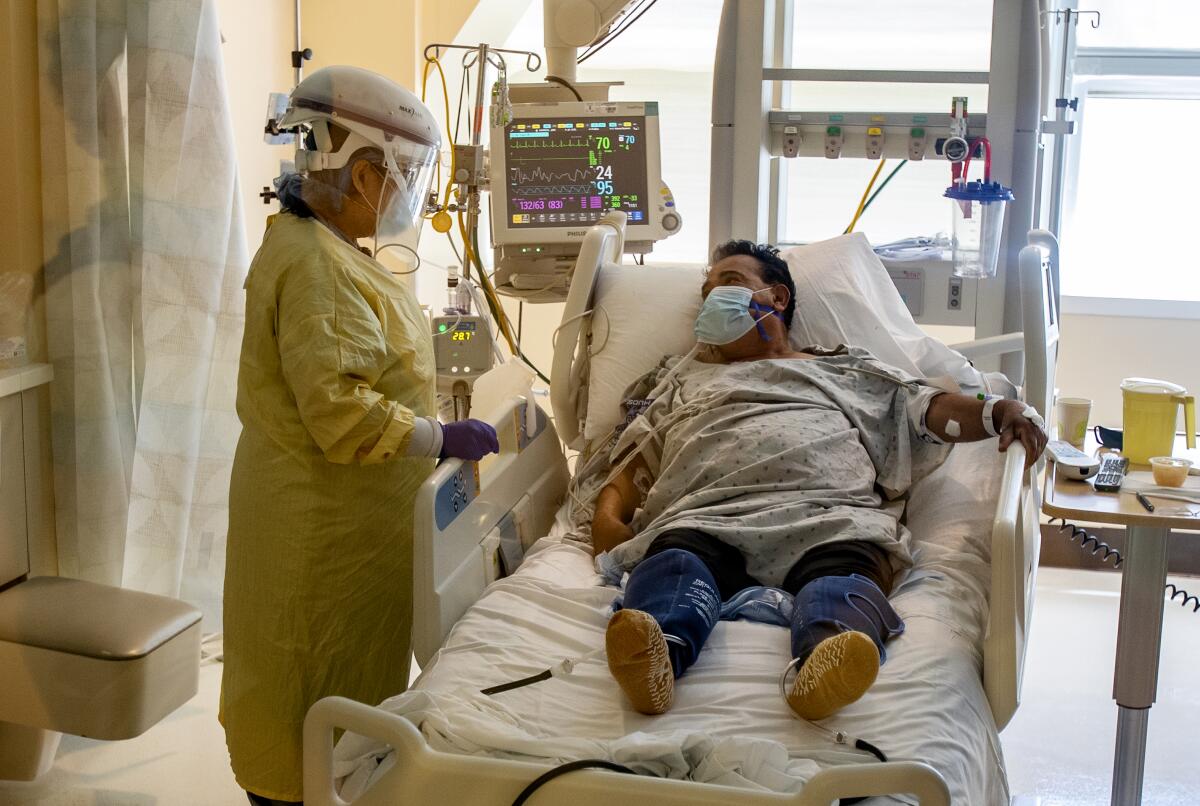Coronavirus infections are higher than ever, but COVID-19 deaths are not. Why?

For months, epidemiologists have predicted a spike in COVID-19 cases as winter approaches. Now it appears those dark forecasts were all too accurate.
Coronavirus infections are rising across much of the United States, with the number of new daily cases nearing 200,000 for the past several days. Thatâs about five times the number of new daily cases the U.S. was reporting as recently as September, according to the World Health Organization.
In California, the average number of new coronavirus cases has tripled in the last month alone. The virus is now infecting more Californians every day than at any previous point in the COVID-19 pandemic, according to a Times analysis.
A winter surge of COVID-19 is now unavoidable, experts say, though its magnitude depends on what we do next. Hundreds of thousands of lives hang in the balance.
While the federal government continues to take a relatively hands-off approach, state and local governments have become more aggressive in hopes of bending the curve on new cases.
In response to growing case numbers, California imposed a statewide 10 p.m. curfew to keep people from gathering and drinking together late at night. New York City closed its public schools for in-person learning less than two months after they reopened. Even Iowa Gov. Kim Reynolds, a longtime opponent of mask mandates, imposed one last week after 50% of Iowans who were tested for the virus got a positive result.
But as infections spiraled to never-before-seen heights, the number of COVID-19 deaths per day has not followed suit.
In early April, the U.S. reported about 30,000 new infections and about 2,000 deaths per day, according to the WHO. Thatâs about the same number of deaths that are being reported now â though daily new cases are more than six times higher.
What exactly is going on? The more coronavirus cases that are reported, the more COVID-19 deaths weâd expect to see, right?
The answer is both yes and no, experts said.
The general consensus is that the number of deaths will eventually follow infections in their upward trajectory, but the ratio of deaths per infection will remain significantly lower than it was in the spring.
Can you have Thanksgiving during the COVID-19 pandemic? Researchers have created an interactive map that estimates the risk youâll face in any county.
There are multiple reasons for this. Some may seem obvious; others, more surprising.
But before we go through them, just remember that if you were hoping that the virus was losing its bite, or that the drop in death rate is a reason to ignore safety protocols, experts say that is not the case.
âThere is no evidence that this virus is becoming less lethal,â said Jennifer Nuzzo, an epidemiologist at Johns Hopkins Bloomberg School of Public Health.
Reason 1: Increased testing
In the early days of the pandemic, coronavirus testing was available only to people who either had a known exposure to the virus or had symptoms of COVID-19. (Although even when those two criteria were met, it could be difficult to get a test.) That means a large percentage of people who were infected were not being counted, especially the âsilent spreadersâ who were asymptomatic and those who had only mild symptoms, Nuzzo said.
As testing has ramped up across the country, and the bar for getting checked has come way down, more infections are being identified. However, since the sickest COVID-19 patients were generally able to get tested all along, improved testing capacity has not made nearly as much difference in counting the number of people who die of the disease.
That dichotomy explains why the percentage of coronavirus cases serious enough to result in death has gone down.
Reason 2: Better treatments
Over the past several months, what began as a scattershot, try-anything approach for treating people with severe cases of COVID-19 has evolved into a set of best practices that have allowed more of the sickest patients to survive, said Dr. Robert J. Kim-Farley, a medical epidemiologist at the UCLA Fielding School of Public Health.
These improved treatment protocols include:
⢠Positioning patients on their stomachs rather than their backs when they are having trouble breathing.
⢠Being more judicious about putting patients on mechanical ventilators and waiting longer to do so.
⢠Administering dexamethasone or other steroids to help suppress the overactive inflammatory response in severely ill patients.
⢠Using the antiviral drug remdesivir, which was originally developed to fight hepatitis C and respiratory syncytial virus but failed to work against either.
⢠In some cases, giving patients virus-fighting antibodies from people who have recovered from COVID-19 (convalescent plasma) or synthetic antibodies designed to attack the coronavirus that causes the disease (monoclonal antibodies). Both are thought to help the immune system recognize and battle the virus more effectively.
âThereâs still no silver bullet, but all these little incremental things are making a measurable impact on our ability to keep people from dying or having severe disease,â Kim-Farley said.
Reason 3: More young people getting infected
âThe biggest thing that has shifted since the spring is the age of the people getting infected,â Nuzzo said.
That makes a difference, because the older the COVID-19 patient, the greater the risk the disease will be fatal.
Early in the pandemic, older people made up a larger share of reported daily new cases. In May, for instance, more than 27% of known infections were in people 60 and older; by August, that figure had dropped to 18%, according to data from the Centers for Disease Control and Prevention. Meanwhile, the proportion of cases among people in their 20s and 30s rose from 32% to 38%.
This shift in age distribution of those infected with the coronavirus has reduced the overall COVID-19 fatality rate. Over the course of the pandemic, people between the ages of 18 and 39 accounted for just 1.8% of the deaths in the U.S., while people 65 and older made up 80%, according to the CDC.
Dr. Mark Dworkin, an infectious disease specialist at the University of Illinois, Chicago, said itâs not surprising that infections have exploded among young adults, because as a general rule, they tend to be less strict about public health measures. Epidemiologists have noted similar trends with HIV, he said: Young people who are infected are more likely to disregard the medication protocols that are important for controlling that virus.
âYou can certainly find plenty of young people who are doing what they need to do, but if you go to a bar, itâs usually not filled with old people,â Dworkin said. âItâs that invincibility of youth. They process risk differently.â
However, as cases climb among younger adults, there will be ripple effects for their elders, Nuzzo added.
âWe have fairly good data that young people donât live in a bubble,â she said. âIn the coming weeks, we should expect to see the virus spread to older populations as well.â
Reason 4: Better-prepared nursing homes
In the spring, nearly half of recorded COVID-19 deaths occurred in nursing homes, Nuzzo said.
Today, most long-term care facilities are far better prepared to fight and contain the virus if it comes through their doors.
âLots of nursing homes have caught up with improving testing, [personal protection equipment] and other infection-prevention measures,â Dworkin said. âAs a result, we are not hearing about as many nursing-home outbreaks as before.â
But as Nuzzo points out, those measures require resources and are not foolproof.
âAs the prevalence of the infection grows, it gets harder and harder to keep the virus out of nursing homes,â she said. âSo we could again see explosive outbreaks there.â
Reason number 5: The lag
Most of us by now know the trajectory of an outbreak. First, infections rise. Several days later, thereâs an increase in hospitalizations, after the virus has had time to incubate and cause severe disease in its unluckiest victims. The rise in hospitalizations is in turn followed a few weeks later by a rise in deaths from those who donât survive their hospital stay.
New coronavirus infections started seriously spiking in the United States in mid-October, so epidemiologists say we are just getting to the point where they would expect to see deaths begin to climb. And indeed, thatâs exactly what the data show.
âWhen I look at the mid- to late-November data, I do see the beginning of an uptick,â Dworkin said. âI believe we will see the deaths increase. It wonât just be a flat line while cases keep rising.â
In other words: If you were hoping for a reason why more infections wonât necessarily mean more deaths, the science just isnât on your side. And even if deaths donât rise over the next couple of months, weâre still looking at 2,000 Americans dying of COVID-19 every day.
âWhy is it acceptable to have that much death when it is preventable?â Dworkin asked.








